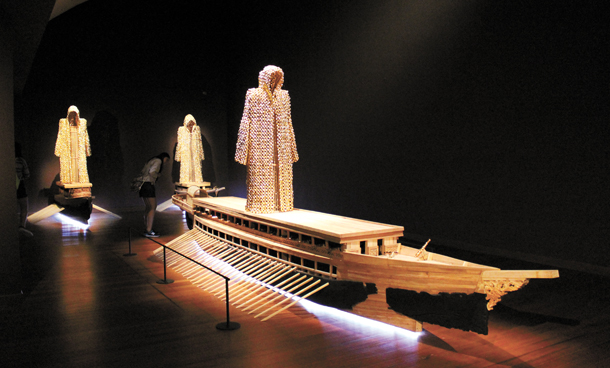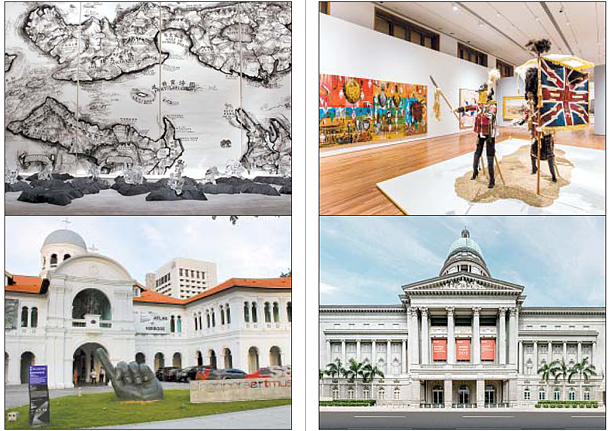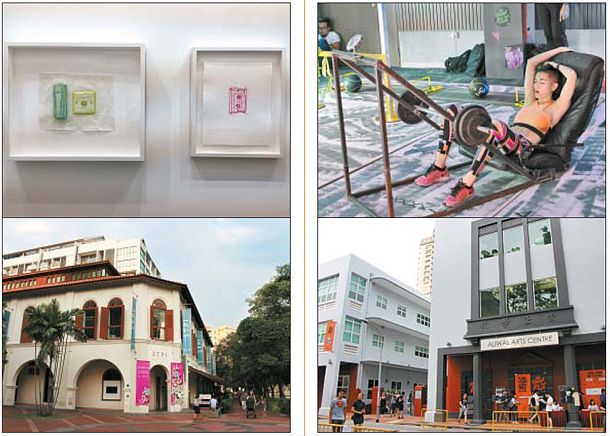Singapore spotlights diverse art offerings : The Lion City sets its sights on being the creative hub of Asia

Indonesian artist Titarubi’s installation work “History Repeats Itself” is part of the fifth Singapore Biennale. [MOON SO-YOUNG]
The annual art week, jointly organized by the National Arts Council, the Singapore Tourism Board and the Singapore Economic Development Board, seems to reflect the city state’s ambition to become the contemporary art hub of Asia.
The seventh Art Stage Singapore fair, held at Marina Bay Sands from Jan. 12 to 15, and the fifth Singapore Biennale, still running at the Singapore Art Museum and other venues, focused on Southeast Asian artists and, at the same time, explored their links to other parts of Asia and other continents. The direction fit well with the identity of Singapore, a multicultural and cosmopolitan state.
The art week might give some clues to Korean art policy makers, who seem to have long been indecisive over whether to emphasize Korean (rather than Asian) identity or pursue globalization.
Here are the highlights of the Singapore Art Week 2017.

From left: Korean gallery Arario’s booth, above, at Art Stage Singapore 2017 and Handiwirman Saputra’s work, top, at the fair’s special show “Collectors’ Stage.” The lotus-shaped ArtScience Museum, above, and Japanese media art group teamLab’s installation work, top, inside the museum. [MOON SO-YOUNG, STB]
A total of 120 galleries from 27 countries participated in the seventh edition of Art Stage Singapore, one of the major Asian art fairs, held between Jan. 12 to 15 at the business and leisure complex Marina Bay Sands.
“Art Stage Singapore distinguishes itself through our unflagging commitment to nurturing the progress of thriving art markets across Southeast Asia,” Lorenzo Rudolf, president of the art fair, said in a statement. The former director of the prestigious Switzerland-based Art Basel fair founded the Singaporean fair in 2010.
As he said, the art market featured many established and emerging artists based in the region as well as other parts of Asia, whereas it didn’t have many major international galleries representing so-called blue-chip Western artists. Five Korean galleries participated in this year’s edition, compared to more than ten in the earlier editions - Arario was the only large-size galley among them.
“Many of the Western galleries that had participated [previously] were absent in the 2017 edition,” Henna Joo, executive director of Arario Gallery, said. “However, collectors from the [Southeast Asian] region were still very active and the market quality developed further. Our gallery’s sales here were also strong, led by Indonesian artist Eko Nugroho, and Filipino artists Leslie de Chavez and Geraldine Javier.”
2. Art and science
Near the Marina Bay Sands stands the ArtScience Museum, which has a beautiful shape reminiscent of a white lotus flower. In front the museum is a lotus pond and in the pond stands a mirror that reflects the inverted image of the museum in the shape of a lotus. It is “Sky Mirror” by renowned British-Indian artist Anish Kapoor.
“After opening in 2011, the museum has focused on exhibitions that link art and science,” said Dawn Wang, senior manager of communications at Marina Bay Sands.
One of the ongoing exhibitions at the museum is “Journey to Infinity: Escher’s World of Wonder.” It is a large-scale retrospective of Maurits Cornelis Escher (1898-1972), a Dutch graphic artist. He is famous for mathematically-inspired enigmatic woodcuts, lithographs, and other prints that explore how to depict impossible spaces, infinity, and the transformation of shapes.
The exhibition, which runs through Feb. 26, features 150 pieces of his work including his famous tesselation series and the depiction of impossible space “Relativity,” which is a steady source of inspiration for ad campaigns and films including the 1986 fantasy film “Labyrinth” starring David Bowie.
The museum also has a permanent exhibition, “Future World,” which features 16 spectacular interactive media art installations by Japanese media art group teamLab.

From left:Qiu Zhijie’s installation work, top, and Lim Soo Ngee’s sculpture, above, on view inside and outside Singapore Art Museum as part of Singapore Biennale. The National Gallery Singapore, above, is running the exhibition “Artist and Empire,” top, which looks at imperialism and colonialism through art. [MOON SO-YOUNG, NATIONAL GALLERY SINGAPORE]
Taking places at the Singapore Art Museum, located on Bras Basah Road, the fifth Singapore Biennale will run until Feb. 26.
Titled “An Atlas of Mirrors,” the international contemporary art show features works by more than 60 artists from across Asia.
“This biennale starts with the simple question “From where we are, how do we see the world - and ourselves?” said Susie Lingham, creative director of the biennial exhibition.
Unlike the still-dominant Western-oriented view of the world, “An Atlas of Mirrors positions Southeast Asia as a vantage point through which we recognise our world anew,” she said.
She explained that whereas an atlas is a navigational tool that enables us to set our sights further, the mirror brings us into the familiar but still-mysterious world filled with one’s self. By combining the contrary characteristics of these devices, “a new instrument of vision and thought is imagined,” the curatorial statement reads.
Among the participants, Chinese artist Qiu Zhijie and Thai artist Pannaphan Yodmanee present spectacular installations that depict world maps created in the artists’ own ways. Qui’s work is a map about the history of the flows of philosophy, mythology and science, while Pannaphan’s work is about the mapping of the Buddhist cosmos.
4. Examining empire
Continuing the theme of a new and different view of the world, an exhibition running at the National Gallery Singapore matches well with the Singapore Biennale.
The exhibition, titled “Artist and Empire” was organized as a collaboration between the Singaporean museum and Tate Britain in London and an exhibition of the same title was held at Tate from Nov. 2015 to April, 2016.
“But the Singaporean version, running here [until March 26], is different from the London version,” said Low Sze Wee, director of curatorial, collections and education at National Gallery Singapore. “This exhibition explores the history of imperialism and the empires’ influences on colonies reflected in diverse artworks from the viewpoint of colonies.”
One part of the exhibition examines art produced for the British Empire from a contemporary perspective, by juxtaposing imperial-era paintings that glorify colonial rule with works by contemporary artists born in former colonies that examine or satire imperialism.
The museum building itself is a summary of Singapore’s history.
The museum, opened in 2015, is housed in two national monuments - City Hall and the former Supreme Court - which were built in the early 20th century under British colonial rule and were elaborately restored over the past decade.

From left:Korean artist Do Ho Suh’s works, top, created in collaboration with STPI, above, at the workshop’s booth in Art Stage Singapore 2017. A performance by Singapore artist group DXXXXD as part of its art project “No Regrets for Our Youth,” top, at the Aliwal Arts Center, above. [MOON SO-YOUNG]
STPI, or the Singapore Tyler Print Institute, is a unique workshop and gallery, specializing in the mediums of printing and paper. Inviting artists from various parts of the world to its residency program to collaborate with its workshop staff, STPI celebrates its 15th anniversary this year.
“We have collaborated with more than 70 leading or emerging artists from around the world to create works,” said Emi Eu, director of STPI. Those artists include big names like Shinro Ohtake of Japan and Do Ho Suh and Haegue Yang of Korea. What is surprising is that many of those artists have oeuvres focused on installation works, which seem to have little relation with printing using woodcut, lithograph and silkscreen.
“With collaborations with those artists, we create unique and experimental works, widening the boundaries of printing,” Eu explained.
For example, Do Ho Suh “created tactile imprints of objects found in the STPI artist studio through frottage, capturing actual physical dimensions and textural characteristics,” according to the workshop’s web site. He participated in the residency program in 2010 and 2015. The works he created in STPI were an extension of his series of works - translucent fabric sculptures that depict home and studio buildings where he stayed, which are visualizations of the memories about the spaces and the ambience therein.
6. Street celebrations
Art events were not only held in major museums during Singapore Art Week 2017. The streets of Kampong Glam conservation district were another venue for a unique art event. The old Malay village with rich cultural heritage has an art institution named Aliwal Arts Centre, which deals with a variety of genres of art but mainly performances. The center held the Aliwal Urban Art Festival in the surrounding streets on Jan. 14 with the theme of celebrating street culture and featured everything from an art and crafts market to skateboarding and street dancing.
An art exhibition titled “No Regrets For Our Youth” is going on inside the center’s building, which was formerly a school. The exhibit features a gymnasium filled with fitness equipment created by Singaporean art team DXXXXD with junk and everyday objects - such as weight lifting equipment made with a used chair and a TV monitor. Visitors were invited to try out the equipment while music and lighting reminiscent of a nightclub were installed to create a high-energy atmosphere. The exhibit looks at the obsession with fitness in Singapore and elsewhere, according to the artists.
At Gillman Barrack, Singapore’s contemporary arts cluster of international art galleries and restaurants set in a former colonial military camp, the Art After Dark show was held and featured night premieres of new exhibitions and performances.
MOON SO-YOUNG [symoon@joongang.co.kr]










with the Korea JoongAng Daily
To write comments, please log in to one of the accounts.
Standards Board Policy (0/250자)